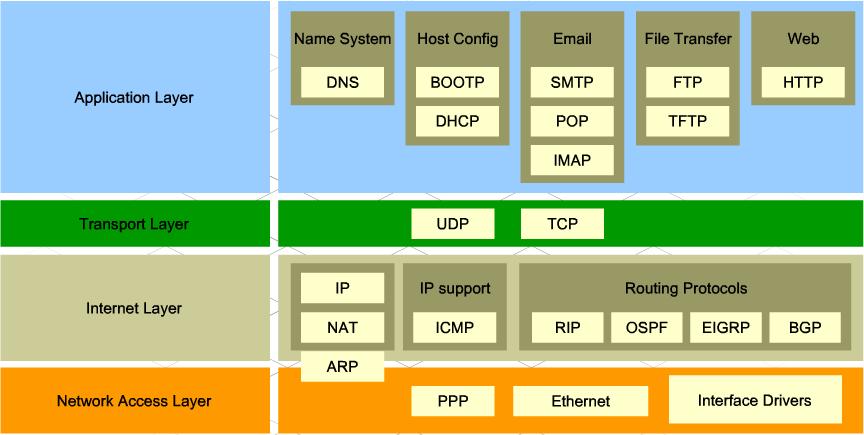When talking about network communications, the first thing you need to understand is the Open Systems Interconnection Model (OSI Model)
For the system design purpose, we don't need to go lower than layer 4.
The most commonly used protocols are summarized in this table:
It is definitely not a complete table, and we are particularly interested in the following areas:
-
TCP vs UDP:
- TCP:
- connection-oriented protocol
- connection established between the peer entities prior to transmission
- transmission flow is controlled such that a fast sender does not overwhelm a slow receiver.
- UDP:
- message-oriented protocol
- basically broadcasting messages, no connection/sequence guaranteed
- TCP:
-
Other transport layer protocols:
- QUIC: Based on UDP, initially designed by google.
- SCTP: Combination of TCP and UDP, used for telephony over the Internet.
-
TCP/IP:
-
HTTP: How does it work when a client wants to communicate with a server
- Open a TCP connection
- Send an HTTP message
- Read the response sent by the server
- Close connection (or reuse connection for further communication)
-
HTTPS:
- Extension of HTTP, but more secure
- Use SSL/TLS to ensure security of data transportation
-
socket:
- A socket is one endpoint of a two-way communication link between two programs running on the network.
- A socket is bound to a port number so that the TCP layer can identify the application that data is destined to be sent to.
-
websocket:
- A WebSocket is a persistent connection between a client and server
- WebSockets provide a bidirectional, full-duplex communications channel that operates over HTTP through a single TCP/IP socket connection
-
HTTP vs Long-polling vs websocket:
- HTTP is a strictly unidirectional protocol
- Long-polling is an HTTP request with a long timeout period
- resources on the server are tied up throughout the length of the long-poll, even when no data is available to send.
- Websocket: allow for sending message-based data, similar to UDP, but with TCP
- uses HTTP as the initial transport mechanism (i.e. HTTP request headers), but keeps the TCP connection alive after the HTTP response is received
- Once TCP connection is established, it uses websocket protocol to communicate
- WebSocket is a framed protocol, meaning that a chunk of data (a message) is divided into a number of discrete chunks, with the size of the chunk encoded in the frame.
- The frame includes a frame type, a payload length, and a data portion.
- More comparison between websocket and http can be seen here
-
REST:
- a software architectural style that was created to guide the design and development of the architecture for the World Wide Web
- Any web service that obeys the REST constraints is informally described as RESTful
- The goal of REST is to increase performance, scalability, simplicity, modifiability, visibility, portability, and reliability.
- Six guiding constraints define a RESTful system:
- Client–server architecture
- client application and server application MUST be able to evolve separately without any dependency on each other
- Statelessness
- The server will not store anything about the latest HTTP request the client made. It will treat every request as new. No session, no history.
- Cacheability
- caching shall be applied to resources when applicable
- Caching can be implemented on the server or client-side.
- Layered system
- allows you to use a layered system architecture where you deploy the APIs on server A, and store data on server B and authenticate requests in Server C
- Uniform interface
- A resource in the system should have only one logical URI, and that should provide a way to fetch related or additional data.
- Code on demand (optional)
- you are free to return executable code to support a part of your application
- Client–server architecture
-
REST vs SOAP
- REST is an architectural style, while SOAP is a protocol
- REST is not a standard in itself, but RESTful implementations make use of standards
-
HTTP response status codes
- For a full list please see here
- Some common ones:
- 200: ok/success
- 201: created
- 202: accepted
- 204: No content
- 300: more than one possible response
- 301: permanent redirect
- 302: temporarily redirect
- 400: The server could not understand the request due to invalid syntax.
- 401: unauthenticated
- 403: Permission denied
- 404: The server can not find the requested resource (URL not recognized)
- 500: Unhandled error on server
- 502: Server got an invalid response
Reference:
- Network Layers & Network Layer in OSI Model
- Application Layer (Internet protocol Suite) ~ Networking Space
- The Internet protocol suite (article) | Khan Academy
- QUIC - Wikipedia
- An overview of HTTP - HTTP | MDN
- What Is a Socket? (The Java™ Tutorials > Custom Networking > All About Sockets)
- WebSockets - A Conceptual Deep Dive | Ably Realtime
- How Do Websockets Work? - Kevin Sookocheff
- Short Polling vs Long Polling vs WebSockets - System Design
- Representational state transfer - Wikipedia
- REST Principles and Architectural Constraints

